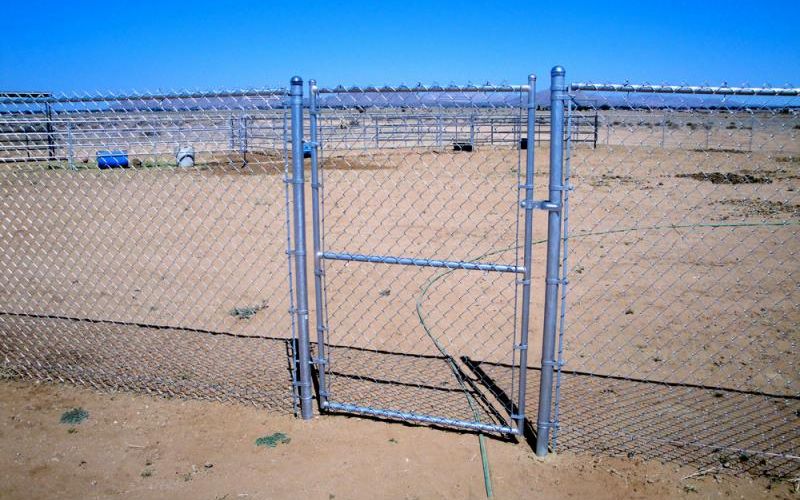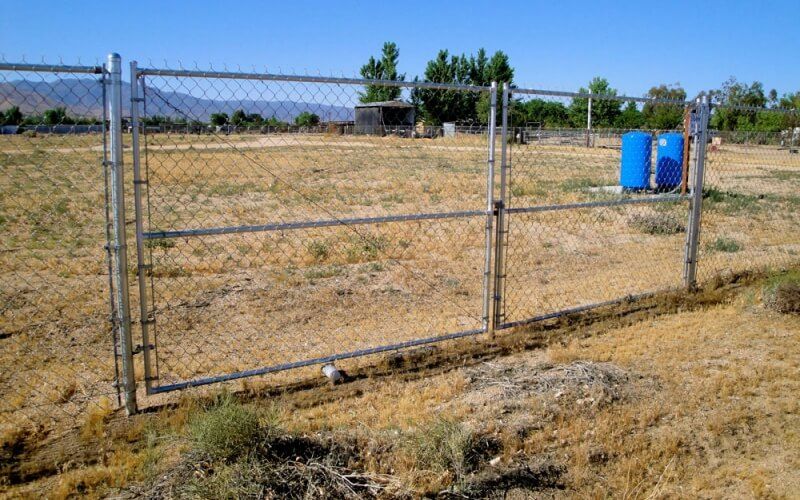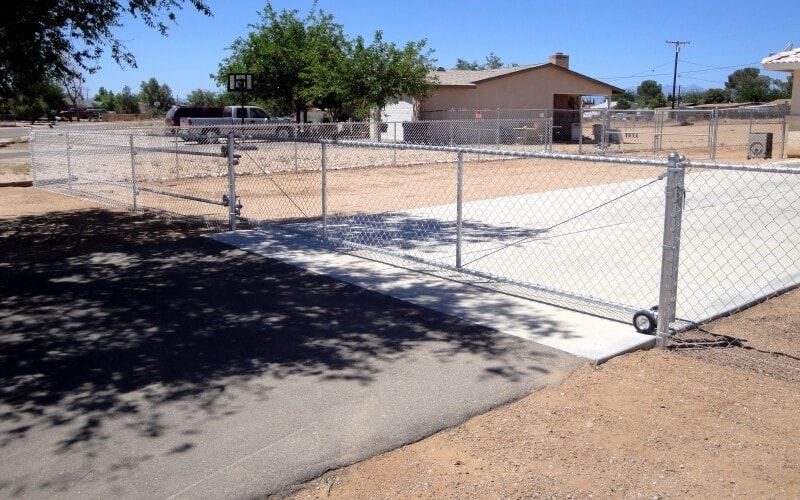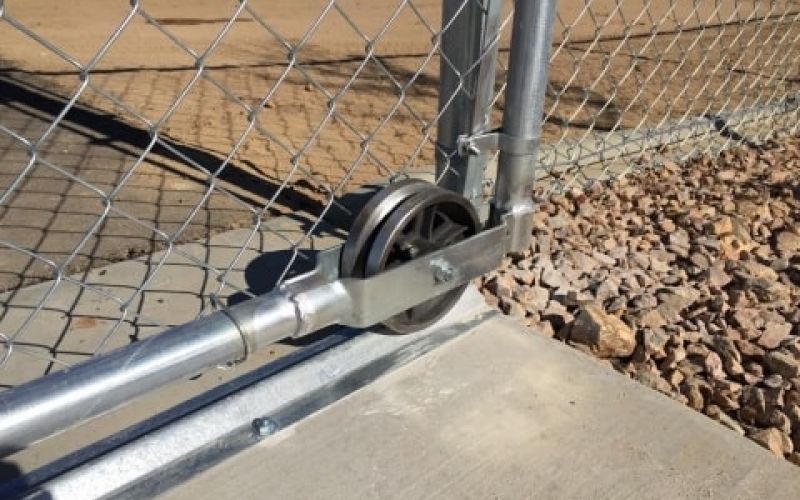Chain link gates are a great option for residential and commercial properties. They're cost-effective, tough, and easy to install. It's important to note there are three types of chain link gates: walk-through/pedestrian gates, chain link rolling gates, and chain link double swing gate/drive-through gates. Walk-through chain link gates are great for allowing pedestrian traffic on and off your property. Rolling gates close off an entrance or exit, whereas double swing gates can be opened in both directions.
Each type of chain link gate has its own pros and cons. Here's what you should know about our chain link gate options at All American Fence Erectors.
{C}
Walk Thru/Pedestrian Gate:
This is the most affordable and convenient gate to use for simply getting from one side of the fence to the other. Walk-through gates are mostly placed in the fence line where sidewalks are or next to the house for ease of use walking around the house from the front yard to the backyard. Most walk-through or pedestrian gate sizes range from 3’-6’ in width, and our most common size is 4’ wide.
This type of gate is also the easiest to open and close. It is meant for pedestrian traffic only so it can be opened by hand or with a handle that attaches to an electric opener. Just like chain link rolling gates or double swing gates, it's a simple and versatile option for ensuring controlled access to your property.
 4x5 walk gate
4x5 walk gate
- This is the most affordable and convenient gate to use for simply getting from one side of the fence to the other.
- Most often walk gates are placed in the fence line where sidewalks are or up next to the house for ease of use walking around the house from the front yard to the backyard.
- Walk gate sizes range from 3’-6’ in width and our most common size is 4’ wide.
Double swing/drive thru gate:
This is the most affordable type of gate to get a car or truck through. Double swing gates range from 10’-20’ in width, and our most common is 12’-16’ wide. Our chain link double swing gates are made with 11 gauge steel, which is thicker than most standard chain link gates. The double swing gate opens up to 180° for ease of use. This allows it to be left open or closed while still providing access at all times.
 6' chain link, 16' double swing gate
6' chain link, 16' double swing gate
- This is the most affordable type of gate to get a car or truck thru.
- Double swing gates range from 10’-20’ in width, our most common is 12’-16’ wide.
Pros
- Most affordable vehicle gate
- Rocky ground or rough asphalt doesn’t affect gate, gate doesn’t touch ground
- Unlike chain link rolling gates, this type of gate doesn’t touch the ground
- Lightweight, swing open and close with little strength/effort
Cons
- Grade under the gate should be relatively level for swing clearance
- In windy conditions gates can get blown around when in use, this can be fixed with gate holdbacks.
- If gate gets slammed it is easy for hinges to spin out of adjustment, but usually easy to fix
- Gates are known to sag if heavy abuse is used
- Installing a gate operator is usually not practical on this type of gate
We recommend this gate if infrequent use and/or rough ground is present.
Rolling gate:
A chain link rolling gate is ideal for main driveways where the gate opening is flat, and concrete is underneath the gate opening. This type of rolling gate is for openings from 12'-20' wide. More often than not, rolling gates get a bad rap for wheels hanging up and gates not rolling straight into the gate latch. The good thing is, this can be solved. A rolling gate works best when there's concrete underneath the gate to mount a strip of angle iron for the gate to track/roll-on (2nd photo). Doing this does bring added cost but is well worth it. The wheels will last longer, and much less effort is used when opening and closing the gate. Angle iron provides a consistent, open and close alignment of the gate, similar to a train riding on train tracks, if you will. Chain link rolling gates are the most popular style in today's market. They offer an easy way to secure a property and provide an aesthetically pleasing look.
 18x4 rolling gate
18x4 rolling gate Rolling Gate
Rolling Gate
This type of gate is ideal for main driveways where the gate opening is flat and concrete is underneath the gate opening. This type of rolling gate is for openings from 12'-20' wide. More often than not rolling gates get a bad rap for wheels hanging up and gates not rolling straight into the gate latch. This can be solved! A rolling gate works hands down the best WHEN there is concrete underneath the gate to mount a strip of angle iron for the gate to track/roll on (2nd photo). Doing this does bring added cost but is well worth it. The wheels will last longer and much less effort is used when opening and closing the gate. Angle iron provides a consistent open and close alignment of the gate, similar to a train riding on train tracks if you will.
Pros of rolling gate:
- Vehicle can be right in front or behind gate and you can still open/close the gate.
- Gate will never accidentally swing and hit a car, because it rolls parallel to fence.
- Most roll gates are single; opposed to a double swing gate where you have to technically open two gates.
- Potential to add a gate operator with addition of angle iron, v-groove wheel, & tail.
- Gate frame pipe is larger than that of a double swing gate.
Cons of rolling gate:
- Chain link rolling gates are often more expensive than a double swing gate
- It can be a physical job opening and closing the gate if the ground surface isn't smooth and flat
{C}
We recommend this gate if you have a smooth flat hard surface (ideally concrete) for the gate to roll on and daily use is needed. This gate will always work best if there is concrete under the gate opening, in which case we can mount the angle iron track so the gate alignment is consistent and perfect. Price reflects these options.
For gate openings larger then 20': Click Here